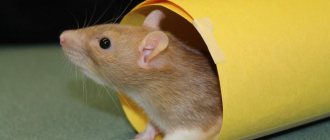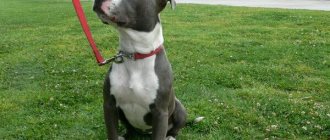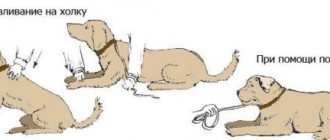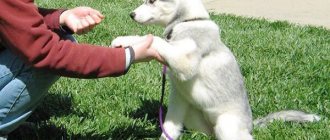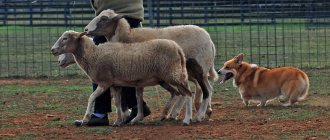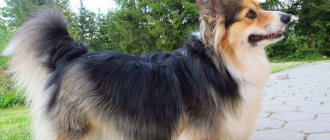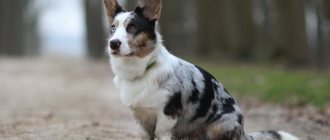The Welsh Corgi owes its origin to the Welsh lands.
There are two varieties of corgis, the Pembroke and the Cardigan, which get their names from the counties where they were bred.
There, both species established themselves as herding dogs and for a long time they dutifully performed their duty.
Therefore, the Corgi’s abilities are appropriate.
The dog has good inclinations, most of which boil down to charisma, and in terms of mental abilities it is a worthy competitor to its fellow colleagues.
Therefore, proper training is an integral part of keeping these dogs.
Where to start learning
As soon as the puppy crosses the threshold of the apartment, he is taught the rules of behavior.
Some dog breeders believe that training is stressful for the dog. The first six months do not injure the animal with loads. Others talk about the productivity of the period. The pet will become closer to the owner during training. Corgis enjoy the process of learning new skills. They owe this ability to their ancestors, who for a long time served as herding dogs. In order to honorably carry out their duty, they were obliged to unquestioningly follow the commands of the shepherd. Representatives of this breed take prizes in competitions.
One of the characteristics of the Corgi is the lack of aggression. This greatly simplifies the training process. But as security guards, they do their jobs poorly.
Take the Attention Test! Find 10 differences! (click right here!)
Find the answer Are you bothered by some problem or question? Enter “Breed” or “Name of the problem” into the form, press Enter and you will find out everything about the issue that interests you.
What should a dog be able to do?
The training is based on both the reinforcement of basic commands (“sit”, “come to me”, “fu”, “near”), and the completion of a general training course (GTC).
Also, due to the distinctive characteristics of the corgi, it is time to try their luck in various activities and competitions.
Currently, Welsh Corgis are not limited to just the status of a pet and are perceived more as a companion dog.
However, they are not predisposed to aggression, and therefore are not in demand in security activities, which cannot be said about a number of other specialties.
The breed is predisposed to:
- work in rehabilitation centers;
- search and rescue service;
- search work (search for things, prohibited means, etc.);
Stages of training
Experts say that the good mental abilities and hard work characteristic of this breed do not require the use of special training methods. These puppies perceive team-game information better. During training, a clear sequence of actions is followed. It is better to conduct classes in a playful way, then the pet will become interested in the process and show good results.
At 2 months, it’s time to teach your pet boundaries: don’t gnaw, don’t bite, don’t bark. They learn to respond to a nickname and establish a sleep schedule.
At 3 months the period of socialization begins. You will need a leash, muzzle, and collar to regulate your pet's behavior. Explain the rules of behavior with people and dogs. Make sure that the dog does not pick it up from the floor.
At 4-5 months, the pet plays around and tests the owner’s character. They teach the basic commands “fu”, “no”, sit”, “place” and others.
At the age of 6 months, they learn the boundaries of what is permitted. It is important to be attentive and strict.
Garden strawberries
February is a favorable time for planting strawberry seeds. With this method of growing, in a few months you will be able to get full-fledged strawberry bushes and save on the purchase of planting material, because rosettes of elite varieties are not cheap today.
Since seedlings of this berry crop sometimes have to wait up to 3-4 weeks, sowing is carried out already in early February. This will allow the mature rosettes to be transplanted into open ground in May or early June. In the next video you can see how to sow garden strawberries as seedlings.
Training rules
Experienced dog breeders adhere to the following rules:
- The initial stages are democratic. The puppy establishes an emotional connection with the person.
- The commands are easy at first, but the tasks become more difficult.
- Praise and treats influence the results.
- The commands must be consistent, otherwise the Corgi will not understand them. This may call into question the authority of the leader
- The dog can move on to a new task only after completing the old one.
- To be productive, the puppy must be in a good mood. The owner is obliged to provide proper care and the necessary diet, regular walks and games.
Corgis are highly trainable, so a dog handler is not required to train the dog. Representatives of the breed are dexterous, resourceful, and happily carry out their owner’s tasks during classes.
Leek
Leeks are grown using the same principle. This vegetable does not boast early ripening and has a long growing season, but it allows you to get thick, vitamin-rich “legs” that, after harvesting, are perfectly preserved in the cellar for six months. For the sake of such pleasure, perhaps, it is worth taking some time with the seedlings and sowing the seeds in boxes filled with fertile soil in the second half of February.
Leeks are grown in seedlings
Owner experience
Do not train your baby if you are in a bad mood, dogs are excellent psychologists, and your depression can rub off on them. Both puppies and adults copy their owner in everything; a loving dog will try to be with you.
Dogs are able to find a special approach to everyone in order to satisfy their whims. There are no two identical puppies or adult pets; each has a different character and habits.
His character in the future depends on training. It depends on you whether your pet will grow up to be a cheerful and devoted friend or a nervous, unsociable creature.
Features of early sowing
It is worth remembering that the February sowing season has its own subtleties, so thoughtlessly filling window sills with seedling boxes and cups is unlikely to pay off in the future with a generous harvest of vegetables or lush flowering of ornamental plants.
This month allows seedlings to be sown only with late-ripening and slow-growing crops that have a long growing season. Therefore, before “gutting” the stocks of stored seeds, turn the packages over and carefully read the characteristics of each crop.
In February, crops with a long growing season are sown for seedlings.
The region where you live is also important. In February, residents of the southern regions can afford to sow seeds for seedlings, who will, without fear, plant the strong seedlings in open ground at the end of April or beginning of May.
The weather conditions of the Moscow region and other central cities are unlikely to allow seedlings to be transplanted into unprotected soil within this time frame. Therefore, at the end of winter, only those who have a greenhouse or greenhouse on their site will be able to enjoy the troubles of seedlings. But for residents of the northern regions, it’s probably too early to worry - February sowing in your case is justified only for owners of good-quality heated greenhouses.
The timing of sowing seedlings varies in different regions
Also, do not lose sight of one more point - the time of seed germination. When calculating the time for sowing seedlings, you must first decide on the moment of planting them in the ground or greenhouse in your region and count back the number of days required to grow seedlings at home. Then, from the received date, you need to subtract a few more days (or weeks), during which the seeds of the “calculated” crop will sprout and produce full shoots above the soil surface (that is, straightened sprouts with open cotyledon leaves).
Full seedlings are seedlings with open cotyledons
As a result, you can easily determine when exactly you can start planting and fill the window sills with the long-awaited green colors.
Why train
Training a dog at home has 3 goals:
- The pet must recognize the owner as a leader.
- The person will know well how to behave with the pet.
- A trained dog is a socially adapted pet.
The owner must choose whether to use deterrents or rewards for a motivational item.
The greatest impact is achieved when the dog receives praise right away.
Containment methods:
- Using objects that can attract the dog's attention. Things that make sharp sounds - whistles, a bunch of keys, a rattle from a tin can with pebbles, etc.
- If the actions are not followed, the dog loses the owner's attention. She is sent to her place without the usual stroking and praise, in a stern voice.
Pet restraint methods can be used on older puppies older than 4 months. If the dog is unbalanced, then this method should not be used.
Ignoring a pet is a more effective technique than physical influence.
Training is quite a labor-intensive task, but teaching a dog to behave correctly is easier than correcting inappropriate behavior.
Pepper
At the same time, bell pepper seedlings are sown, which can be transplanted to a permanent place 50-65 days after germination. If you sow dry pepper seeds, it takes 10-12 days to germinate. Therefore, it makes sense to pre-wet the seed before swelling in a solution of some stimulant (for example, take Epin). Then the seeds need to be slightly dried to a free-flowing state and sown in the prepared container.
For a novice trainer
To prevent training from turning into torture:
- Take your pet for a walk beforehand. A tired, running dog is less distracted. The effect will be greater. Active walking makes working with the animal easier.
- The command is spoken once.
- Take pauses. When practicing, for example, “near”, “lie down”, “fetch”, you need to give the dog time to take a breath. 5-10 seconds will be enough.
- Change the sequence. If the dog gets used to doing everything in order. That, for example, after “to me” you need to “sit.”
- You can't overload it. Too intense training can harm the animal.
An already trained dog follows commands under any conditions. But your pet may get tired.
- Sometimes students, like ordinary schoolchildren, “run away from class.” They may be distracted by a nearby cat or other animal. Be more careful with your exposure. Train her on a long leash. This will allow you to catch up with the “mischievous person”, even if he runs fast. A leash with a carabiner for 3-5 meters is suitable. Often such a leash is just needed for endurance and training to pick up “goodies” from the floor.
- “Mass” training is not allowed. Only the owner should act as a trainer. Otherwise the dog will be distracted.
- It's worth pausing. If the animal doubts the correctness of the actions, the reason is the load. Give your dog a simple command and then praise generously. When she sees that the owner approves of him, she will begin to perform the exercises better. Play or take a walk with her.
- Commands are studied systematically and gradually. You need to train your pet to obey in any conditions. Start in a quiet place, gradually adding more “stimulants.” Create them. For example, scatter treats, call a friend to pass by the training place.
To train an animal, you need to be patient and perform the exercises systematically.
https://dog-care.ru/dressirovka/obuchenie/kak-dressirovat-velsh-korgi-pembrok.html
How to stop barking and biting?
If the animal does not suffer from any ailments, then most likely the problem is dominance.
Owners rarely take into account the behavior of dogs: whether it is an attempt to grab hands, legs, when a person passes by, or disregard for orders.
The same command “give”, when the owner tries to take away some object from the dog’s mouth, is met with a wall of stubbornness, moreover, aggression.
A bite is a last resort . An intentional desire to cause pain, to show through force who the leader is.
Recommendations:
- Maintain the dog-owner relationship. Don’t try to see your pet as your equal—a human.
- Stop unwanted behavior from your dog. Feel free to use commands: “no”, “fu”, etc.
- Strive to get a response from the dog. Encourage if the order was carried out; otherwise, reprimand.
Same with barking. By the way, special devices are sold for him: muzzles, special collars, “anti-bark devices.”
Each of which is designed to combat the pet’s unpleasant habits.
General training course
The general training course is based on systematic training. The skills developed during the general course form the basis for the formation of conditioned reflexes in the animal.
The first skill is to teach the puppy to go to the toilet only outside. During the learning process, it is necessary to practice instructions with gestures and voice.
General skills and abilities include:
- Response to nickname;
- Habit of a collar, leash, harness;
- Approach to the trainer;
- Walking nearby;
- Habit of lying, sitting, standing, crawling positions;
- Ability to follow voice commands, stop certain actions, overcome obstacles;
- Refusal of other people's food;
- Tolerance to noise stimuli.
OKD
This is a special training program developed in the 1920s and slightly adjusted by modern dog handlers. It is necessary for comfortable coexistence with the dog and is aimed at teaching commands and developing an adequate attitude to various stimuli.
Classes on OKD (general training course) are conducted under the guidance of an instructor and take place in the form of group or individual lessons.
General principles of animal training
To successfully train a pet, systematic training is necessary. The duration of the lesson should not exceed 2 hours. Commands for dogs: the list of techniques practiced in the lesson depends on the level of training of the animal; for example, a Labrador puppy begins to be trained from the first months. Gradually the number of teams should be increased.
New techniques are practiced in the first part of the lesson. After each command, a three-minute break is required for the pet.
Rules for successfully training a puppy:
- Techniques performed correctly should be reinforced with praise and encouragement.
- It is better to voice the instruction once, accompanied by a gesture.
- Maintaining consistency in orders and gestures.
- The first classes are conducted in a familiar environment, then change the environment.
- The trainer and the dog are in a good mood.
- It is better to end the lesson with an instruction that the puppy does better than others.
How to instill in a puppy the skill of following the owner's orders?
When purchasing a puppy for home, most people hope to raise it into a reliable protector in the future. However, until the time when hope meets expectations, the pet can cause a lot of trouble until he learns to understand the meaning of commands, without which the puppy will be uncontrollable. The undertaking will require a lot of patience and perseverance from the owner of the future defender. Often, improper training of a corgi leads to disappointment; many complain about the unfortunate choice of a puppy who is not endowed with the ability to learn simple actions. Most likely, this is, in most cases, a deep misconception. The explanation is simple - the training method is incorrect. You need to look for an individual approach to any puppy, and adhere to the indispensable rule; up to a certain age, the pet must know one owner and get used to taking food only from his hands. This will be the beginning of mutual understanding between man and dog.
Release command
The instruction “Walk” (“Walk” or “Fri”) is a release for dogs that serve in the search and protective guard service.
A professionally working dog, when he is outside the apartment or outside the enclosure, is in a state of “at work”. He rests according to the instructions “Lie down” or “Place”.
If you release your pet with the word “Go for a walk,” then no training is required, the dog will remember it at the same time.
Command your pet to “Sit”, and then release it, joyfully saying “Walk!” If he doesn’t move, then you can, repeating “Walk, walk,” pat her a little, clap your hands, or run forward.
Take breaks every 15-20 minutes.
How to train an adult dog to behave outdoors
Going outside begins with selecting the right type of leash (for example, a classic short one), which not only will not cause unnecessary discomfort to the pet, but will also force it to stay close to the owner.
Many dogs feel excited just by the sight of a leash, not to mention the knowledge that they are about to go outside . The excited pet begins to pull on the leash and interfere with the owner in every possible way.
But before taking measures to suppress unwanted behavior, it is advised to understand what causes it. The reason for this is often the formed associative series: leash-walk.
Get ready to destroy it:
- Attach the leash to the collar, but do not go for a walk; on the contrary, continue to do your business.
- On average, the wait time takes 10-20 minutes before the owner goes to unfasten the leash.
- Repeat the steps until the dog loses interest in this item.
While walking, try to understand what causes the tendency to pull on the leash..
If you want to get to some place, then don’t follow the lead. Achieving a goal for a dog is akin to a reward, and not suppression of an action on the part of the owner is akin to encouragement.
"Place" indication
Command “Place” and entice him with a treat. On the lounger, praise and give a piece.
Gradually increase the time between arrival and reward, and then give treats occasionally. In everyday life, the “Place” command is used when a pet behaves badly (for example, begging from the table or jumping on guests).
By giving the "Place" command, you tell the dog exactly where he needs to go. They quickly grasp the meaning of this command and leave offended.
If he pesters you, then you need to command “Place” again in a more menacing tone.
Before teaching the “Place” command, make sure that the dog knows the “Lie” and “Come” commands.
Step 1: Place him on a long leash and make him lie down.
Step 2. Place a large item, such as a backpack, next to it. Do not use someone else's things or his things (muzzle, toy or bowl).
Step 3. Repeat the “Down” command to him and move away 5 steps.
Step 4: Wait 3 seconds and then command “Come.” When he approaches you, praise him.
Step 5. Give the “Place” command by pointing your hand at the backpack. Move towards the thing, but don't pull on the leash. As you walk, joyfully repeat: “Place. Place".
Step 6. Once in place, command “Down” and give a treat.
Repeat the exercise. Get him to go to the place without your help. Gradually increase the distance and stop using the leash.
The pet must approach the thing lying 15 meters away, lie down and wait (30 seconds) for you to allow it to leave the position. Teach him to stay still when people or animals walk nearby.
If the dog breaks away without a command, bring it back, repeating: “Place.” If the dog refuses to return to its place without you: call the dog left near the thing, sit it next to you and command “Wait.” Then show the dog the treat and go to the “spot” alone. Place it on your backpack and return to the dog. Command “Place”, and if the dog runs up to the thing and lies down, praise it and let it eat a piece.
Welsh Corgi breeds
The dogs were bred in Wales and are divided into two breeds. They're called:
- Welsh Corgi Cardigan;
- Pembroke Welsh Corgi.
Dogs of different breeds lived in neighboring counties, but did not intersect, so there were many differences between them.
Their similarities are only in their small stature, unusual short legs and peculiar ears, as well as in their wonderfully loyal character.
Cardigan is larger, stockier and his face, even in the photo, will remind you of a miniature shepherd dog. The Pembroke is not such an ancient breed as the Cardigan, it looks more aristocratic and sophisticated, a bit like a Spitz.
Photo of Welsh Corgi Cardigan
Their main difference is the tail. Cardigans have a long and wide tail, while Pembrokes have no tail or have one docked at birth.
Cardigan Welsh Corgi puppies behave more respectably and reservedly, they are very loyal. Pembroke puppies are very playful and friendly, more active.
It’s up to you to decide which breed you choose, but in any case, such a dog will become your reliable friend.
Common mistakes when training
- The dog is unconscious of its actions and does not understand human speech. When giving a command, you cannot talk; conditioned reflexes are inhibited. All commands are pronounced without further ado.
- Violations of the order of skill development. From simple to complex. Until the dog has mastered a certain command well, you cannot proceed to the next one.
- The dog handler does not take into account the characteristics of the animal, which reduces the effectiveness of training.
- Retraining. Frequently practicing the same skills helps to fatigue, reduce performance and overload the nervous system. Once the technique is learned, it is no longer performed that day. If she refuses to perform a skill as a result of overtraining, then she is given a rest for 2-3 weeks. Dog handlers monitor the condition of the dog during training.
- Incorrect voice intonation changes the sound of the command. You cannot pronounce everything in one intonation, otherwise it loses its significance as an irritant. The dog will stop responding to her.
- Incorrect use of directions. You can’t repeat it often, otherwise you’ll develop the skill of doing it when you repeat it.
Health
Welsh Corgis, like all herding dogs, are naturally endowed with good health and strong immunity. But there is still a predisposition to certain diseases:
- Spinal diseases - sometimes occur due to an elongated torso.
- Von Willebrand disease is a hereditary disease characterized by blood clotting disorders and spontaneous bleeding. Often leads to death.
- Epilepsy – accompanied by seizures.
- Hip dysplasia is a deformation of the joints, accompanied by severe pain and lameness.
- Raw eczema – skin lesions.
- Eye diseases.
- Degenerative myelopathy is a severe progressive neurodegenerative disease that leads to paralysis of the lower extremities.
- Cystinuria is the abnormal presence of cystine in the urine.
- Skin asthenia is a hereditary disease.
- Difficult childbirth occurs due to the fact that the bitch has 1-2 large puppies (especially if the dog is a firstborn). A caesarean section is often necessary.
With proper care, a Corgi can live 11-13 years. To keep your pet healthy, it is necessary to have timely vaccinations and preventive examinations at a veterinary clinic.
Result:
All the rules described above are necessary in order to raise a calm, strong, obedient and intelligent dog. You need to follow them throughout your Corgi's life, but it will be easier if the puppy starts learning from birth.
Hello, my name is Alexandra Perelishina. I have been working as a practicing dog handler for many years, and I am also a professional corgi breeder. All this time I have been writing articles about corgi care, breeding basics and standards of this breed. I want to share my knowledge with all breed lovers.
Source
